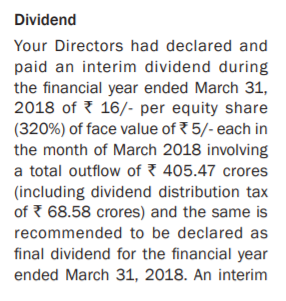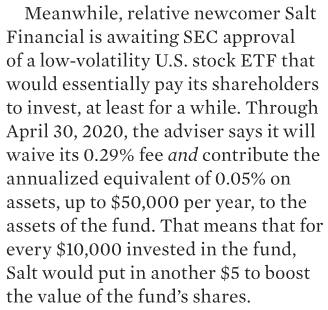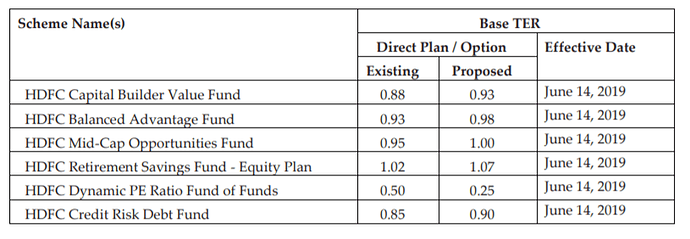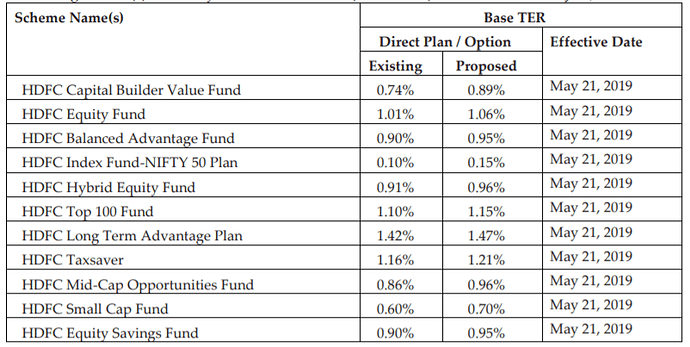https://www.bseindia.com/xml-data/corpfiling/AttachLive/87faec60-fa18-482f-ad3d-b650a4b76ae2.pdf
I think it was before IPO. The below screenshot from last year annual report

The fall in TER is on expected lines, I’d assumed a fall in blended expense ratio by 20-25 bps (across both direct & regular plans) so this is within the range.
My estimate for FY20 is that one will see a slight revenue growth but a healthy (15%+) bottom line growth since AMC’s will pass on a good chunk of this to distributors. A lot of distributor friendly measures have also been stopped since Nov and this will lead to a reduction in discretionary expenses.
Disclosure: I am a SEBI registered investment adviser and have bought this for personal portfolio and other customer portfolios over the past 60 days. I may add more based on market conditions and quarterly results
HDFC AMC press release for Q4 result:
https://www.bseindia.com/xml-data/corpfiling/AttachLive/b8a36bca-a158-40c2-8c93-c0857c63f0c6.pdf
Very good results
Things to note in FY19 vs FY18 -
Revenue up 10% while PAT is up 31%
Yield on AUM (Investment Income/AUM) down to 0.55% from 0.59% - this is understandable and expected since commission now gets paid from scheme books and then the balance gets credited to the AMC books as revenue.If you do the math this yield fell in Q3 and Q4 and brought down the annual number by 4 bps, on a full year basis this impact should be around 8 bps.
Steep fall in brokerage & other expenses since all commissions now being paid from the schemes from Oct onward rather than from AMC books
Effect of lower TER will kick in only from April 2019 onward, so no impact in FY19 numbers
Key takeaways (at least the way I see it) -
More or less supports the hypothesis that power balance is in favor of AMC rather than channel
Next 2 Q’s too will show an accounting spike in profits since the upfront fee that was being paid till Oct 2018 will now be spread out over 36 months (refer explanation given in Q3 conf call)
AMC has a lot of control on discretionary expenses which it can pass on to distributors whenever it wants to, managing profits should not be too much of an issue even after TER cut
Lower TER will show up in muted revenue growth through FY2020, will normalize from Q1 FY2021 onward due to adjustment of base. I would not be surprised if the Investment Income/AUM (yield) drops down below 45 bps for FY2020
I cannot see any expense item that can scale faster than revenue growth after Q2 FY2020
No change in long term view, if anything certain hypothesis have gotten reinforced. Come to your own conclusions, especially on the valuation
Disclosure: I am a SEBI registered investment adviser and have bought this for personal portfolio and other customer portfolios over the past 60 days. I may add more based on market conditions and quarterly results
In Q1 FY20, can we expect almost similar cost but lower revenue (to the extent of reduction in TER from April 1)?
To answer your Q - Yes, my sense is cost will more or less stay at the Q3 and Q4 level - adjusted slightly higher for the annual employee hike in May.
Impact of TER one can asses at the overall AUM level, would be a reasonable estimate so say that yield on AUM might fall by 8-10 bps (equity MF’s TER falls lower by 25 bps in regular plan and 15 bps in regular plan, equity aum is approx 50% of total aum hence at overall aum level impact is 10 bps blended) assuming the upfront ban had not happened.
However given that the upfront commissions have stopped and that this upfront fee now gets spread over 36 months instead of immediate impact in Q1, this blended expense ration falls gets cushioned to a good extent. Hence my back of the hand calculation tells me that the yield on the overall AUM might come down below 0.5% for Q1 and onward.
At the revenue level, one can assume that AUM is 15% higher for Q1 FY2020 than for Q1FY2019. Adjusted for this I would expect Q1 FY2020 revenue to be flattish or maybe slightly lower compared to Q1 FY2019.
However since we are taking a 4-5 year view on this story, the summary would be muted revenue growth for FY2020 over FY2019 while profit growth should be healthy (15%+)
EDIT: Reliance Nippon AMC Q4 results declared earlier today https://www.bseindia.com/xml-data/corpfiling/AttachLive/cadb1b07-16bc-4456-b0af-dba3d6c42e48.pdf
One can pretty much see the same thing play out here too, see the dip in revenue but the spike in PAT. AMC’s are using the current regulatory action to push lower commissions down the distributors throat and improving their profitability as a result.
This is contrary to what most analysts predicted once the TER cuts were announced by SEBI in Oct 2018. Classic case study of doing excel based math in their AC cubicles without understanding how channel dynamics and the balance of power between AMC and distributor works in real life AMC’s are clearly emerging better off not just in the medium term but the immediate short term as well. It took some deep analysis and number crunching to figure this out but once I saw the discretionary nature of most of the expenses for an AMC it kind of sealed the deal for me. I’ve pretty much put out the entire analysis of this aspect in post #232 in this thread here
Hi @zygo23554,
Your contribution to this thread has been immense and truly helpful to understand the intricacies of the AMC business.
I want to understand the basic work-flow of a single investment transaction and how it impacts the accounting at AMC’s side. So below is a hypothetical investment transaction and some of my assumptions. I will very much appreciate if you can confirm/correct my assumptions. Please feel free to alter the hypothetical transaction to make better sense for me. I hope this will help other readers as well.
Hypothetical Transaction: Investor A decides to invest Rs. 1 lakh lump-sum through Distributor A in HDFC Fund A which has TER of 1%. HDFC AMC has agreement with Distributor A to share 60% of TER and retain 40% with themselves. Let’s assume Investor A gives Rs. 1 lakh cheque to HDFC AMC for Fund A on 1/5/2019 and it gets cleared the same day. Investor A gets 1000 units of Fund A with NAV of Rs. 100 on 1/5/2019.
Assumptions:
- Its 1 month now into this investment. Let’s assume the NAV of Fund A remains Rs. 100 on 1/6/2019 and the average NAV for the month of May was Rs. 100.
- HDFC Fund A will charge 1%/12 for month of May, which comes out to Rs. 1000/12 = 83.33
- Investors units will fall down to 999.17
- HDFC Fund A will record revenue of Rs. 83.33 on 1/6/2019
- HDFC Fund A will pass on Rs. 50 to Distributor A (60% of TER) on 1/6/2019. This will be recorded as expense. Is this expense recorded under ‘Other Expense’?
- HDFC Fund A will retain Rs. 33.33 and use these funds to run its operations.
- Assuming NAV remains Rs. 100 forever, above sequence of events will continue every month for 36 months and Investor A’s shareholding of units will keep falling appropriately.
- Assuming Investor A is still invested after 36 months, Distributor A will not get any trail commission post 36 months. Trail commission on given investment can last only for 36 months – right?
Thank you very much for your help.
Industry practice is that expense is charged on a quarterly basis taking the daily average. Also the number of units never changes, only investor can sell/buy units. What AMC does to recover fee is to reduce the NAV to the appropriate extent
Please note that the expense/fee is collected by the scheme and not by the AMC. So as you rightly said, fund A records revenue then pays out the commission to the distributor. As for how expenses get accounted at the scheme level, this is the actual snapshot from the HDFC Top 200 Fund annual filing
| 2018 - HDFC Top 200 Fund AUM | ||||
|---|---|---|---|---|
| Direct | Regular | |||
| AUM | 2160 | 12430 | ||
| Expense Ratio | 33.05 | 282.16 | 315.209 | 2.23% |
| Management Fee | 175.28 | 1.20% | ||
| Service Tax | 30.2 | |||
| Transfer Agent Fee | 10.95 | |||
| Custodian Fee | 0.78 | |||
| Trustee Fee | 0.13 | |||
| Commission | 103 | 0.83% | ||
| Investor Education | 3.01 | |||
| Other Operating Exp | 1.57 |
Now the key thing to note is that cash inflow and cash outflow of the scheme are always matched. So the trail commission is paid out to distributor on a quarterly basis too, after upfront commissions have been banned, there is no cash flow mismatch at the scheme/AMC level. So what distributor makes is on a proportionate basis, if the trail commission is 60 bps per year, he gets 15 bps per Quarter
At this point of time, after the distributor commission is paid out the fund A transfers this fee to the books of the AMC. We as investors are invested into the AMC and not the specific fund. If there are 100 such schemes (combination of debt, equity & hybrid), every scheme does this and transfers the revenue to AMC books
Once again it is the NAV that falls and not the no of units. Units getting impacted by anything other than shareholder’s instruction is a flouting of MF/AMFI regulations. Only exception being a dividend reinvestment scheme where fresh units are issued based on NAV once the dividend gets reinvested
Distributors get paid an annual trail - which is what makes it an annuity model for them and hence a good business to run. To explain clearly -
When upfront commissions existed - Say a scheme has a commission structure that says 50 bps upfront and 50 bps trail, upon the investment getting completed the distributor makes 0.5% of the AUM immediately (on the very same day). If the trail were to start from day 1, he also makes 0.5% of the average AUM in addition to the upfront commission
After upfront commission ban - Say AMC has now decided to make the commission structure 80 bps trail per annum from day 1. So what they are doing is the 0.5% of AUM trail as explained above remains unchanged. The balance 30 bps gets spread over 36 months and this component stops after 36 months. While the 50 bps trail continues. This is what HDFC AMC has been explaining on the past 2 conf calls
Key thing to note is that AMC is reducing distributor commission as and when there is regulatory action like stopping upfront commission, reducing. Most of the impact (80%+) is getting passed on to the distributor this way
Thank you, @zygo23554! Beautifully explained. A layman like me who is new to AMC business and trying to understand its intricacies, couldn’t figure it (just balance 30bps getting spread over 36 months and not full commission structure) through last 4 concall transcripts. Much appreciated.
And I forgot to mention earlier that kudos to you for figuring out channel dynamics and sharing how the balance of power lies with AMC and not distributors. It takes deep understanding of the AMC biz to figure out that AMC had a lot of control on discretionary expenses which it can pass on to distributors whenever it wants to, and managing profits should not be too much of an issue even after TER cut. Great work!
For FMP investment in Essel group
Thanks
Ashit
Not related to HDFC AMC but we can infer few key things from it:

Source: Kiplinger’s Personal Finance Magazine - June 2019 edition
Lately I have been reading a lot of Zero-Fee ETFs being launched by new incumbents in the US. TER is waived for initial year or so and then normal charges are charged. Above screenshot shows that Salt Financial has gone beyond Zero-Fee ETF model and it would in fact pay investors to invest in their ETF. Height of desperation. Not sure if it is sustainable business model but only time will tell.
This shows that having reputation and size in AMC industry becomes industry leader’s biggest competitive advantage. BlackRock would never do something like this. It’s just too difficult for new and small players to make their mark and give big players run for their money. At the same time, onus will always remain on big players to perform and not make any blunders.
Disc: invested and accumulating and hence my views will be biased.
Manish Chokhani quite bullish on AMC’s




